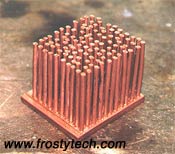
TOP 5 Heat Sinks TOP 5 Low Profile Heat Sinks TOP 5 Liquid Coolers
Heatsinks by Brand / Mfgr Reviews + Articless Advanced Search
 |
TOP 5 Heat Sinks TOP 5 Low Profile Heat Sinks TOP 5 Liquid Coolers Heatsinks by Brand / Mfgr Reviews + Articless Advanced Search |
Overclocking with the CopperPins Heatsink With the making of the CopperPins done it's now time to test out the cooling power it contains. For our tests we are going to be using a PPGA Celeron 300 and a Pentium III 500E FC-PGA. The 300Mhz Celeron is an old processor true, but this particular chip is very overclockable and I know a little more about what it can do, what it has never been able to do, and what it won't do, better then any other processor I have at the moment. The FC-PGA is really just in there for fun. I don't have a mother board with a FSB setting above 155Mhz to really test it out :(  Outline of tests: Using an MSI-6163 mainboard, some PC-100 ram and
A small amount of silicon thermal compound was used as an interface between the copper base and the dies/heatspreaders. To attach the heatsink to the socket, wire was looped around the clips of the socket 370, and then through the pins of the heatsink (much like the Alpha pal35 does). Given the weight of the copper heatsink this method mostly just held the heatsink in place, rather then apply any form of significant downward force on the die. Celeron 300 Tests First on the testing block is the PGA Celeron 300. Ambient temperature was 24.2 C. The thermistor was located on the surface of the copper base directly above the CPU die, and insulated from the surrounding air with a small bit of anti-static foam.
Anyhow it performed fairly well, and from the range of temperature values it took all the increases in temp up until around 40 degrees, where changes then became largely muted.
|
|
|||||||||||||||||||||||||||||||||||||||||||||||||||||||
|
Find a Heatsink . Latest Heatsink Reviews . Top 5 Heatsinks Tested . Top 5 Low Profile Heatsinks . Top 5 Liquid Coolers . Heatsinks by Mfgr / Brand |
Social Media |
FrostyTech.com Info . Feedback . Contact Us / Heatsink Submissions . Submit News . Privacy Policy |
 | |
© Copyright 1999-2025 www.frostytech.com All Rights Reserved. Privacy policy and Terms of Use Images © FrostyTech.com and may not be reproduced without express written permission. Current students and faculty of accredited Universities may use Frostytech images in research papers and thesis, provided each image is attributed. | ||||